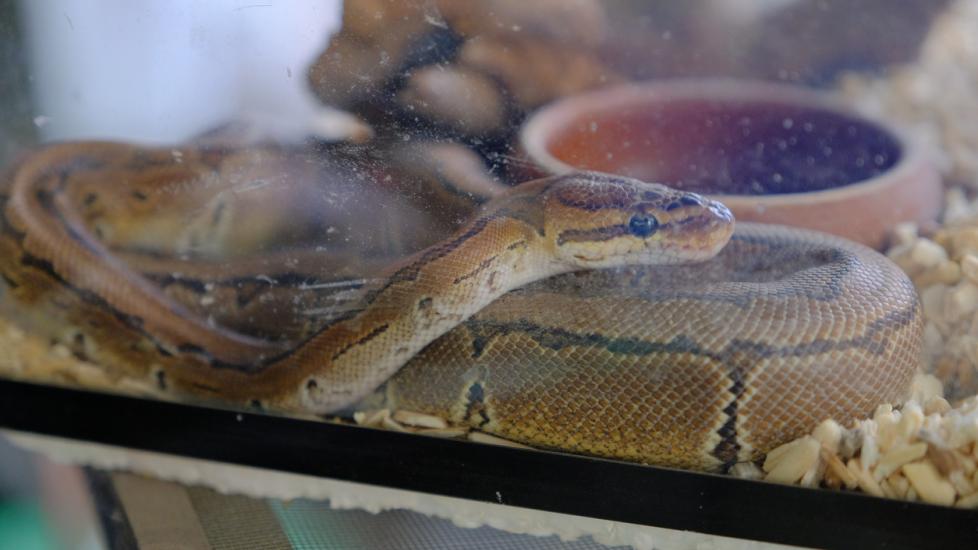What Do Snakes Eat?
Snakes are reptiles that are becoming increasingly popular as pets. While there are many types of snakes, both as pets or in the wild, the diets of pet snakes are generally pretty similar. Most pet snakes are fed some type of rodent–with the size, quantity, and frequency of feeding determined by the size and age of the snake. Wild snakes are also carnivores but may eat anything from mammals to invertebrates.
Diet Considerations
Snakes do not need to eat every day. The frequency at which they need to eat is determined by their size and age. Some of the things a pet snake might eat include:
-
Baby mice or rats
-
Adult mice or rats
-
Young birds like chicks
When feeding snakes, there are some guidelines to keep in mind. It is not recommended to provide live prey as this can lead to prey bites to the snake. If possible, it’s also ideal not to feed the snake in their own enclosure, and instead move them to another spot first to prevent cage aggression and ingestion of substrate. Good care management is also critical to upkeep the appetite and interest in food of snakes.
While snakes don’t particularly need to bond with an owner over treats the way a dog or cat does, feeding a varied diet can help bring something special to a snake’s quality of life. Depending on the size of the snake this can include varying smaller mammals for some of their diet or providing raw meat or eggs.
The best way to maintain a balanced diet for a snake is to provide whole prey–offering some variety of mice and rats. For these whole prey items, you’ll want to stock frozen prey that aren’t live, then thaw them to room temperature before feeding.
Young and/or small snakes may eat as frequently as twice a week. Larger or older snakes (also depending on the size of the prey being fed) may eat as little as only a few times a month.
Live vs Frozen Prey for Snakes
Frozen prey is the diet of choice for snakes.
Pros:
-
Safest feeding option
-
More convenient to store
-
Providing live prey incurs ethical concerns
-
Cost effective
-
Smaller chance of parasite transmission
Cons:
- Some snakes, especially when sick, need the movement and smell of live prey to entice them to eat
The only reason to feed live prey is when a snake completely refuses to eat otherwise. Even then, the recommendation is to provide 1-day old pinkies (newborn rodents) that cannot hurt the snake, then offer again the thawed, previously frozen prey.
What Can Snakes Not Eat?
Snakes should not be fed:
-
Fruits
-
Vegetables
-
Grains
-
Processed foods
All snakes are carnivores—they should eat whole prey only as much as possible for a balanced diet. If offering human foods, they typically can’t deviate from raw meats or eggs.
How to Feed a Snake
You’ll want to purchase appropriately sized whole frozen prey from a pet store and keep it stored in a freezer. When feeding day is approaching, transfer the prey you plan to feed to its own bag and move from freezer to the refrigerator to thaw. Food should be ready in 1-2 days.
A few hours before planning to feed, take the prey out of the refrigerator so they can come up to room temperature. Make sure you have washed your hands and do not smell like the prey, then transfer your snake from their enclosure to an appropriately sized plastic container with air holes. Place the whole, thawed prey inside with them. Wait for your snake to fully consume their meal before transferring them back to their main enclosure.
In snakes that stress easily and are already reluctant to eat, it may be more appropriate to feed prey in their enclosure, keeping in mind the risks associated (aggression and substrate ingestion).
Snakes striking at a prey do not necessarily aim well or selectively. It is important not to transfer the prey into the feeding tub by hand and to do so with relatively long tools such as tongs that will keep your hands a safe distance away. Do not place the prey in the box before transferring the snake as they may start striking blindly once they smell it and while you’re still transferring their food.

References
- Finch, N. Basic Snake Medicine. Veterinary Information Network. 2010.
Featured Image: iStock.com/Natt Boonyatecha
